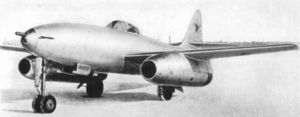Sukhoi Su-9 Video - Overview
|
|
Sukhoi Su-9
Su-9/Su-11/Su-13

Picture - Sukhoi Su-9
Role: Fighter
Manufacturer: Sukhoi
First flight: 13 November 1946
Retired: 1948
Status: Prototype only
Primary user: Soviet Air Force
Number built: one Su-9, one Su-11
The Sukhoi Su-9, or Samolyet K (Russian: Aircraft K), was an early jet fighter aircraft built in the Soviet Union shortly after World War II. The Su-9 also served as the basis for the Su-11 (Samolyet KL) and Su-13 (Samolyet KT).
Design and development
Su-9
At the end of WWII the Soviet government were painfully aware how far behind the rest of the world Soviet gas turbine technology had fallen. To enable airframe designers to gain the benefit of flight research, the use of captured German engines, and copies built in Soviet factories, was authorised. Sukhoi's OKB started work in May 1944 on a straightforward twin-engined fighter, known in-house as 'Samolyet K'. Using conventional construction with duralumin and steel the Su-9 was equipped with advanced features for the time with an ejection seat and a provision for JATO bottles (2x 11.27 kN/2,530 lbf thrust for 8 seconds). as well as, for the first time on a Soviet aircraft, a brake parachute and unique wing-mounted air brakes. These were mounted between the ailerons and the engine nacelles and split above and below the wing. The aircraft was revealed to the general public on 3 August 1947 at the Tushino Airfield. Development of the Su-9 was hampered by the stigma associated with its resemblance to the Me 262 (While it bore a superficial resemblance to the German Messerschmitt Me 262, the Su-9 was not directly related to that aircraft). Competing aircraft designer Aleksandr Yakovlev played this fact against Sukhoi with Joseph Stalin. The Su-9 was abandoned in favour of the more advanced Su-11 (LK).
Su-11
In early 1947, it was decided to modify the prototype two-seat Su-9 trainer, then under construction, into the Su-11, (Samolet KL), replacing the German Jumo 004B engines with more powerful Soviet-designed Lyulka TR-1 turbojets developing 12.7 kN (2,865 lbf) thrust each, wing and fuselage structure was also revised to adapt to the considerably larger Lyulka engines. Work was completed in May 1947, with first flight of the Su-11 taking place on 28 May 1947, with G.M. Shiyanov at the controls, becoming the first Soviet designed aircraft to fly with indigenous jet engines. The Su-11 first flew on 28 May 1947 test flights revealed yaw instability at high speeds. The Lyulka engines were also found to be unreliable eventually being cancelled. With no engine available the Su-11 project was abandoned in April 1948.
Su-13
The Su-13, (Samolet KT), was the final attempt to further increase performance of the basic Su-9 design, using wing sections reduced from 11% to 9% thickness/chord ratio and swept tailplanes. The aircraft was also fitted with a pair of Klimov RD-500 (unlicensed Rolls-Royce Derwent copies) engines with 15.6 kN (3,500 lbf) thrust each. A night fighter version with radar and two 37 mm Nudelman N-37 cannon was also proposed. However, the projected top speed below 1,000 km/h (540 kn, 621 mph) was deemed insufficient and the project was abandoned before the prototype could be finished.
Operators
Soviet Union
Soviet Air Force
Specifications (Su-9)
Data from
General characteristics
Crew: One
Length: 10.57 m (34 ft 8 in)
Wingspan: 11.21 m (36 ft 9 in)
Height: 3.72 m (12 ft 2 in)
Wing area: 20.24 m˛ (217.87 ft˛)
Empty weight: 4,060 kg (8,950 lb)
Loaded weight: 5,890 kg (12,990 lb)
Max takeoff weight: 6,380 kg (14,070 lb)
Powerplant: 2x— Tumansky RD-10 turbojets, 8.8 kN (1,984 lbf) each
*Fuel capacity: 1,750 kg (3,860 lb)
Performance
Maximum speed: 885 km/h (480 kn, 550 mph) at 5,000 m (16,405 ft)
Range: 1,140 km (615 nmi, 710 mi)
Service ceiling: 12,800 m (41,984 ft)
Rate of climb: 4.2 min to 5,000 m (16,405 ft)
Wing loading: 291 kg/m˛ (60 lb/ft˛)
Thrust/weight: 0.31
Endurance: 1 hour 44 minutes
Armament
1 x— 37 mm Nudelman N-37 cannon with 30 rounds (1 x— 45 mm Nudelman N-45 could be fitted instead)
2 x— 23 mm Nudelman-Suranov NS-23 cannon with 200 rpg
Up to 500 kg (1,102 lb) of bombs (1 x— FAB-500 or 2 x— FAB-250)
Heinkel He 178 - The world's first aircraft to fly under turbojet power.
Heinkel He 280 - The first turbojet-powered fighter aircraft built in the world.
Comparable aircraft
Messerschmitt Me 262 - The world's first operational jet-fighter aircraft.
Gloster Meteor - The first Allied operational jet-fighter aircraft.
Bell P-59A
Nakajima J9Y Kikka
Su-1, 3
Shavrov, V.B. . “Istoriia konstruktskii samoletov v SSSR, 1938-1950 gg. (3 izd.)”. 1994. Mashinostroenie. ISBN 5-217-00477-0
Green, William. “The Great Book of Fighters”. 2001. MBI Publishing.ISBN 0-7603-1194-3
Shavrov, V.B. . “Istoriia konstruktskii samoletov v SSSR, 1938-1950 gg. (3 izd.)”. 1994. Mashinostroenie. ISBN 5-217-00477-0
Gunston, Bill. The Osprey Encyclopaedia of Russian Aircraft 1875-1995”. London, Osprey. 1995. ISBN 1 85532 405 9
Living Warbirds: The best warbirds DVD series.
Source: WikiPedia